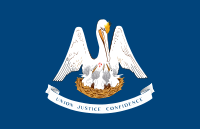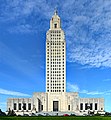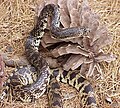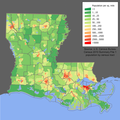The Louisiana Portal Louisiana (French: Louisiane [lwizjan] ⓘ; Spanish: Luisiana [lwiˈsjana]; Louisiana Creole: Lwizyàn) is a state in the Deep South and South Central regions of the United States. It borders Texas to the west, Arkansas to the north, and Mississippi to the east. Of the 50 U.S. states, it ranks 20th in land area and the 25th in population, with roughly 4.6 million residents. Reflecting its French heritage, Louisiana is the only U.S. state with political subdivisions termed parishes, which are equivalent to counties, making it one of only two U.S. states not subdivided into counties (the other being Alaska and its boroughs). Baton Rouge is the state's capital, and New Orleans, a French Louisiana region, is its largest city with a population of about 383,000 people. Louisiana has a coastline with the Gulf of Mexico to the south; a large part of its eastern boundary is demarcated by the Mississippi River. Much of Louisiana's lands were formed from sediment washed down the Mississippi River, leaving enormous deltas and vast areas of coastal marsh and swamp. These contain a rich southern biota, including birds such as ibises and egrets, many species of tree frogs—such as the state recognized American green tree frog—and fish such as sturgeon and paddlefish. More elevated areas, particularly in the north, contain a wide variety of ecosystems such as tallgrass prairie, longleaf pine forest and wet savannas; these support an exceptionally large number of plant species, including many species of terrestrial orchids and carnivorous plants. Over half the state is forested. Louisiana is situated at the confluence of the Mississippi river system and the Gulf of Mexico. Its location and biodiversity attracted various indigenous groups thousands of years before Europeans arrived in the 17th century. Louisiana has eighteen Native American tribes—the most of any southern state—of which four are federally recognized and ten are state recognized. The French claimed the territory in 1682, and it became the political, commercial, and population center of the larger colony of New France. After a brief period of Spanish rule, Louisiana was returned to France in 1801 before being purchased by the U.S. in 1803; it was admitted to the Union in 1812 as the 18th state. (Full article...) Entries here consist of Good and Featured articles, which meet a core set of high editorial standards.
Elisabeth Dieudonné Vincent (1798 – 29 November 1883) was a Saint Dominican Creole, businesswoman and international migrant. Born in 1798 in Saint-Domingue to an affranchi and French father, she was illegitimate, although her father did acknowledge her. In 1803, the family fled from the violence of the Haitian Revolution to Santiago de Cuba, where they completed paperwork to show that they were free. In 1809, when the Spanish authorities expelled French colonists because of the Peninsular War in Europe, she moved to New Orleans in Louisiana. Vincent married in 1822 and with her husband, Jacques Tinchant, operated a business in New Orleans. The couple also earned money by renting out Vincent's slaves. In 1835 she amended her original marriage record in order to acquire a surname, removing the double stigma of illegitimacy and slave ancestry. Experiencing racial inequality and increasing restrictions as a result of the demanding Black Codes in the United States, they moved with their family to France, where they operated a dairy and vineyards in Gan. Poor economic conditions and violence during the French Revolution of 1848 prompted the family to relocate to Antwerp in 1857, where they invested in their sons' new tobacco business. (Full article...)Selected article - The fauna of Louisiana is characterized by the region's low swamplands, bayous, creeks, woodlands, coastal marshlands and beaches, and barrier islands covering an estimated 20,000 square miles (52,000 square kilometers), corresponding to 40 percent of Louisiana's total land area. Southern Louisiana contains up to fifty percent of the wetlands found in the Continental United States, and are made up of countless bayous and creeks. The Creole State has a humid subtropical climate, perhaps the best example of a humid subtropical climate of all the Southern United States with long, humid and hot summers and short, mild winters. The subtropical characteristics of the state are due in large part to the influence of the Gulf of Mexico, which at its farthest point is no more than 200 miles (320 kilometers) away. Louisiana's varied habitats — tidal marshes, bayous, swamps, woodlands, islands, forests, and prairies — offer a diversity of wildlife. (Full article...)General images -The following are images from various Louisiana-related articles on Wikipedia.
Did you know -
Related portalsTopicsCategoriesNew articlesThis list was generated from these rules. Questions and feedback are always welcome! The search is being run daily with the most recent ~14 days of results. Note: Some articles may not be relevant to this project.
Rules | Match log | Results page (for watching) | Last updated: 2024-04-24 21:32 (UTC) Note: The list display can now be customized by each user. See List display personalization for details.
WikiProjectsTasks
Associated WikimediaThe following Wikimedia Foundation sister projects provide more on this subject:
SourcesDiscover Wikipedia using portals |

Sons of Union Veterans of the Civil War











































































